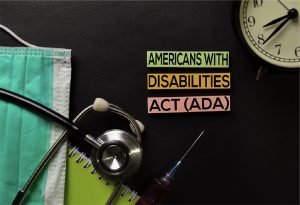How to Determine When Protections Apply to ADA and COVID “Long Haulers”
 The emphasis is on “might” since the ADA does not provide a checklist of covered conditions. Employees’ cases must be reviewed on an individual basis to determine whether they have physical or mental impairments that substantially limit a major life activity such as breathing, thinking, sleeping or working.
The emphasis is on “might” since the ADA does not provide a checklist of covered conditions. Employees’ cases must be reviewed on an individual basis to determine whether they have physical or mental impairments that substantially limit a major life activity such as breathing, thinking, sleeping or working.
The ADA, implemented in 1990, ensures that people with dis-abilities have the same rights and opportunities as everyone else. It also guarantees equal opportunity for individuals with disabilities in public accommodations, employment, transportation, state and local government services and tele-communications.
This year the Department of Justice (DOJ) and Health and Human Services (HHS) jointly issued guidance on COVID-19 disabilities. While some people who have mild or moderate COVID-19 can have symptoms that last about two weeks, others — referred to as long haulers — can be left with debilitating side effects.
Examples of situations where a COVID-19 long-hauler might be substantially limited in a major life activity would include, according to the DOJ and HHS:
- Lung damage that causes shortness of breath, fatigue and related effects
- Intestinal pain, vomiting and nausea that have lingered for months
- Memory lapses and brain fog.
Employees with these symptoms do not automatically qualify for assistance under the ADA. An individualized assessment is necessary. Assessments must be based on reliable medical or other objective evidence rather than on generalizations, subjective impressions, fear, patronizing attitudes or stereotypes.
In addition, employees who recover quickly from the disease and are not covered by the ADA may be covered by the Family and Medical Leave Act (FMLA). The FMLA provides certain employees up to 12 weeks of unpaid, job-protected leave per year. It also requires that the employee be allowed to keep their group health benefits during the leave.
Accomodations
Any request for accommodation must pro-vide an opportunity for the employee with a dis-ability to achieve the same level of performance and to enjoy benefits equal to someone who doesn’t have a disability.
Reasonable requests for accommodating a disability can include:
- Making existing facilities used by employees readily accessible to and usable by an individual with a disability
- Restructuring a job
- Modifying work schedules
- Acquiring or modifying equipment
- Providing qualified readers or interpreters
- Modifying examinations, training, or other programs
- Reassigning an employee to a vacant position they may be qualified for if they are unable to do their original job.
Whatever the accommodation, the employer does not have to provide any accommodation that creates an undue hardship on the business. For instance, employers are not required to lower quality or production standards as an accommodation; nor are they obligated to provide personal use items such as wheelchairs, prescription glasses or hearing aids.
Resources
The Equal Employment Opportunity Com-mission (EEOC) enforces workplace anti-discrimination laws, including the ADA, and the Rehabilitation Act. These acts include the requirement for reasonable accommodation and non-discrimination based on disability, and rules about employer medical examinations and inquiries. Visit www.eeoc.gov/coronavirus for more information.
Since guidance from public health authorities has been changing as COVID-19 has evolved, employers should continue to seek the most current information on maintaining workplace safety. Some resources include:
- The Centers for Disease Control and Prevention’s (CDC) “Interim Public Health Recommendations for Fully Vaccinated People” at www.cdc.gov/coronavirus/2019-ncov/vac-cines/fully-vaccinated-guidance.html
- The CDC’s Frequently Asked Questions about COVID-19 Vaccination: https://www.cdc. gov/coronavirus/2019-ncov/vaccines/faq. html
- The EEOC publication “Pandemic Prepared-ness in the Workplace and the Americans with Disabilities Act” at www.eeoc.gov/sites/default/files/2020-04/pandemic_flu.pdf
- The EEOC “3/27/20 Webinar” at www.eeoc. gov/coronavirus